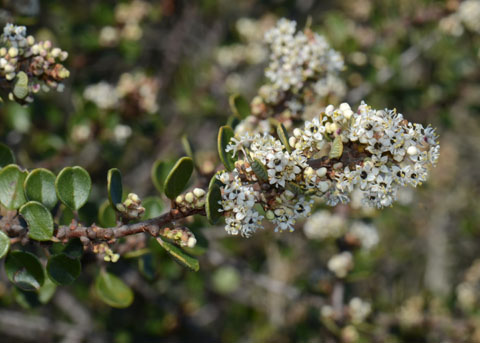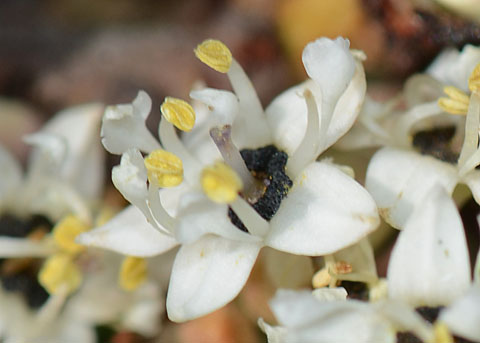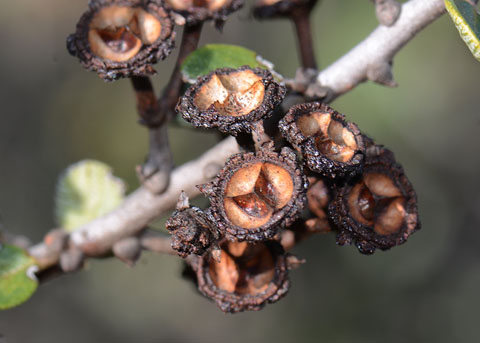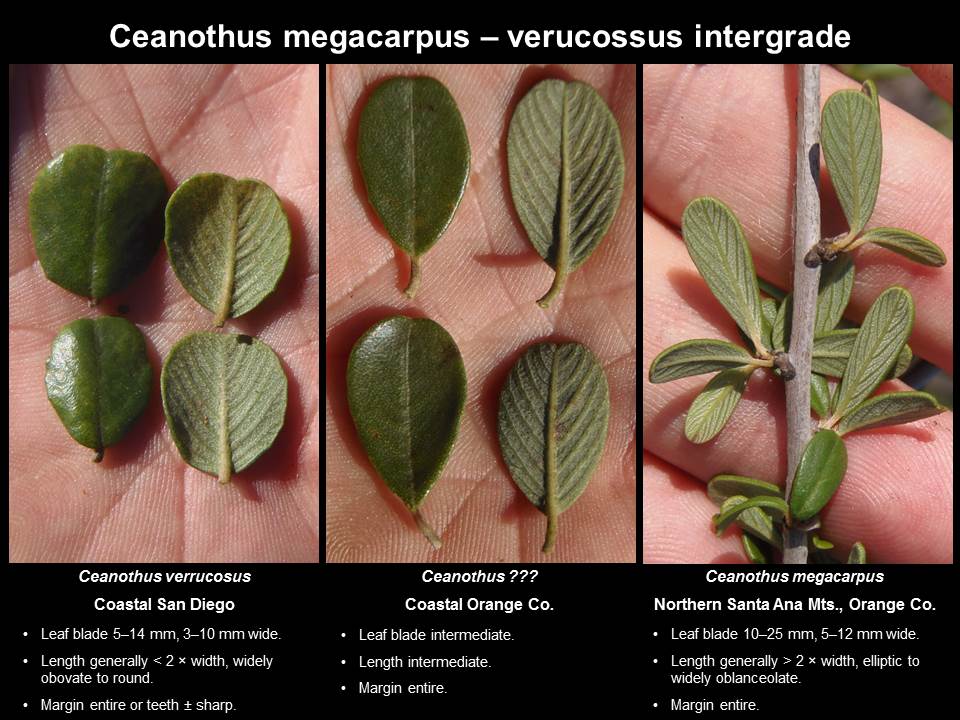 Moulton Meadows, Aliso and Wood Canyons Wilderness Park, Laguna Beach, CA. 12-22-11. © Peter J. Bryant |
Bigpod Ceanothus Ceanothus verrucosus-megacarpus complex A common evergreen shrub growing to 12 ft. tall in chaparral of the northern Santa Ana Mountains in the vicinity of Sierra Peak and Coal Canyon. An isolated coastal population (illustrated here) is found in the San Joaquin Hills where it is locally common at Los Trancos Canyon, southern Temple Hill and Niguel Hill (Roberts). "These shrubs appear to be distinct from the interior populations with habit and leaf characters similar to Ceanothus verrucosus, but with typical C. megacarpus fruits. These plants have been referred to as members of a "Ceanothus verrucosus-C. megacarpus complex"(Roberts). This species does not sprout from the root crown after fire as most chaparral shrubs do. In summer, usually July, seedpods explode ejecting millions of hard seeds which may sprout after fire many years later. (McAuley, Wildflowers of the Santa Monica Mountains). A small population of Ceanothus in the coastal hills of Orange County has been variously called Ceanothus verrucosus and Ceanothus megacarpus. It does not quite fit either species and may represent an intergrade of these two disjunct taxa. Back to Rhamnaceae of Orange County, California |
/Moulton%20Meadows%20,%20Aliso+Wood%20Cyns.%20Wilderness%20Park,%20Laguna%20Niguel,%20CA%2012-23-11%20069.jpg) Moulton Meadows, Aliso and Wood Canyons Wilderness Park, Laguna Beach, Orange County, CA. 12-23-11. © Joan Avise. |
/Seaview%20Park,%20Aliso+Wood%20Cyns.%20Wilderness%20Park,%20Laguna%20Niguel,%20CA.%20%205-29-11%20121.jpg) Leaves are alternate, often notched at the apex 3/4 in. long. They are dull green and rough on top with fine hairs on the underside. There are 2 thick stipules at the base and one main leaf vein. Seaview Park, Aliso and Wood Canyons Wilderness Park, Laguna Niguel, Orange County, CA. 5-29-11. © Joan Avise. |
/%20UCI%20Arboretum%203-6-10%20034.jpg) Cultivated at UCI Arboretum, Irvine, Orange County, CA. 3-6-10. © Joan Avise. |
/Seaview%20Park,%20Aliso+Wood%20Cyns.%20Wilderness%20Park,%20Laguna%20Niguel,%20CA.%20%20%205-29-11%20058.jpg) Seaview Park, Aliso and Wood Canyons Wilderness Park, Laguna Niguel, Orange County, CA. 5-29-11. © Joan Avise. |
/Moulton%20Meadows%20,%20Aliso+Wood%20Cyns.%20Wilderness%20Park,%20Laguna%20Niguel,%20CA%2012-23-11%20080.jpg) The white to pale lilac 5-merous flowers are in small clusters. Moulton Meadows, Aliso and Wood Canyons Wilderness Park, Laguna Beach, Orange County, CA. 12-23-11. © Joan Avise. |
/Seaview%20Park,%20Aliso+Wood%20Cyns.%20Wilderness%20Park,%20Laguna%20Niguel,%20CA.%20%20%205-29-11%20054.jpg) Seaview Park, Aliso and Wood Canyons Wilderness Park, Laguna Niguel, Orange County, CA. 5-29-11. © Joan Avise. |
 Moulton Meadows, Aliso and Wood Canyons Wilderness Park, Laguna Beach, Orange County, CA.. 12-22-11. © Peter J. Bryant |
/Seaview%20Park,%20Aliso+Wood%20Cyns.%20Wilderness%20Park,%20Laguna%20Niguel,%20CA.%20%205-29-11%20052.jpg) Seaview Park, Aliso and Wood Canyons Wilderness Park, Laguna Niguel, Orange County, CA. 5-29-11. © Joan Avise. |
/Seaview%20Park,%20Aliso+Wood%20Cyns.%20Wilderness%20Park,%20Laguna%20Niguel,%20CA.%20%20%205-29-11%20048.jpg) The large-sized green to reddish seedpods up to 1/2 in. are barely lobed, laterally horned with low crests. Seaview Park, Aliso and Wood Canyons Wilderness Park, Laguna Niguel, Orange County, CA. 5-29-11. © Joan Avise. |
/Seaview%20Park,%20Aliso+Wood%20Cyns.%20Wilderness%20Park,%20Laguna%20Niguel,%20CA.%20%20%205-29-11%20044.jpg) Seaview Park, Aliso and Wood Canyons Wilderness Park, Laguna Niguel, Orange County, CA. 5-29-11. © Joan Avise. |
/Seaview%20Park,%20Aliso+Wood%20Cyns.%20Wilderness%20Park,%20Laguna%20Niguel,%20CA.%20%20%205-29-11%20116.jpg) Seaview Park, Aliso and Wood Canyons Wilderness Park, Laguna Niguel, Orange County, CA. 5-29-11. © Joan Avise. |
 Empty pod cups. Moulton Meadows, Aliso and Wood Canyons Wilderness Park, Laguna Beach, Orange County, CA. 12-22-11. © Peter J. Bryant |
 Niguel Hill to Aliso Peak, 12-6-15. © Ron Vanderhoff. |
 Niguel Hill to Aliso Peak, 12-6-15. © Ron Vanderhoff. |
 Niguel Hill to Aliso Peak, 12-6-15. © Ron Vanderhoff. |
|
 Niguel Hill to Aliso Peak, 12-6-15. © Ron Vanderhoff. |
|
 A comparison of the foliage of all three taxa shows part of the taxonomic problem. The uncertain population is that in the center, and is intermediate of the two species. From foliage alone, these problematic plants would seem to align more closely with C. verrucosus of San Diego County. © Ron Vanderhoff. |
|
The local ranges of the three taxa involved. ORANGE: Ceanothus megacarpus (which also ranges further North). PINK: C. verrucosus, which is strictly a coastal San Diego (and Baja) species. The plants in question are the small BLUE polygons to the upper left. These are clearly coastal, like verrucosus, but are isolated from both species. © Ron Vanderhoff. In the meantime it is an interesting dilemma of what to call these plants. Current references seem to place them as C. megacarpus. |
|